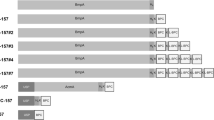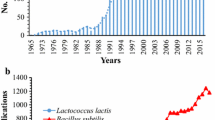Abstract
β-Galactosidase is an essential enzyme for the metabolism of lactose in human beings and has an important role in the treatment of lactose intolerance (LI). β-Galactosidase expressed by intestinal microflora, such as lactic acid bacteria (LAB), also alleviates LI. A promising approach to LI management is to exploit a food-grade LAB delivery system that can inhabit the human intestine and overproduce β-galactosidase. In this study, we constructed a food-grade β-galactosidase surface display delivery system and then integrated into the chromosome of Lactococcus lactis (L. lactis) NZ9000 using recombination. Western blot and immunofluorescence analyses confirmed that β-galactosidase was expressed on the cell surface of recombinant L. lactis stain NZ-SDL. The whole-cell biocatalyst exhibits Vmax and Km values of 121.38 ± 7.17 UONPG/g and 65.36 ± 5.54 mM, based on ONPG hydrolysis. The optimum temperature for enzyme activity is 37 °C and the optimum pH is 5.0. Activity of the whole-cell biocatalyst is promoted by Mg2+, Ca2+, and K+, but inhibited by Zn2+, Fe2+, and Fe3+. The system has a thermal stability similar to purified β-galactosidase but better pH stability, and is also more stable in artificial intestinal juice. Oral administration and intraperitoneal injections of NZ-SDL in mice cause no detectable health effects. In conclusion, we have successfully constructed a food-grade gene expression system in L. lactis that displays β-galactosidase on the cell surface. This system exhibits good enzyme activity and stability in vitro, and is safe in vivo. It is therefore a promising candidate for use in LI management.






Similar content being viewed by others
References
Oliveira C, Guimaraes PM, Domingues L (2011) Recombinant microbial systems for improved beta-galactosidase production and biotechnological applications. Biotechnol Adv 29(6):600–609. https://doi.org/10.1016/j.biotechadv.2011.03.008
Saqib S, Akram A, Halim SA, Tassaduq R (2017) Sources of beta-galactosidase and its applications in food industry. 3 Biotech 7(1):79. https://doi.org/10.1007/s13205-017-0645-5
Gibson GR, Roberfroid MB (1995) Dietary modulation of the human colonic microbiota: introducing the concept of prebiotics. J Nutr 125(6):1401–1412
Cummings JH, Macfarlane GT, Englyst HN (2001) Prebiotic digestion and fermentation. Am J Clin Nutr 73(2 Suppl):415S–420S
Bayless TM, Brown E, Paige DM (2017) Lactase non-persistence and lactose intolerance. Curr Gastroenterol Rep 19(5):23. https://doi.org/10.1007/s11894-017-0558-9
Di Rienzo T, D’Angelo G, D’Aversa F, Campanale MC, Cesario V, Montalto M, Gasbarrini A, Ojetti V (2013) Lactose intolerance: from diagnosis to correct management. Eur Rev Med Pharmacol Sci 17(Suppl 2):18–25
Husain Q (2010) Beta galactosidases and their potential applications: a review. Crit Rev Biotechnol 30(1):41–62. https://doi.org/10.3109/07388550903330497
Shaukat A, Levitt MD, Taylor BC, MacDonald R, Shamliyan TA, Kane RL, Wilt TJ (2010) Systematic review: effective management strategies for lactose intolerance. Ann Intern Med 152(12):797–803. https://doi.org/10.7326/0003-4819-152-12-201006150-00241
Masood MI, Qadir MI, Shirazi JH, Khan IU (2011) Beneficial effects of lactic acid bacteria on human beings. Crit Rev Microbiol 37(1):91–98. https://doi.org/10.3109/1040841X.2010.536522
Song AA, In LLA, Lim SHE, Rahim RA (2017) A review on Lactococcus lactis: from food to factory. Microb Cell Fact 16(1):55. https://doi.org/10.1186/s12934-017-0669-x
Morello E, Bermudez-Humaran LG, Llull D, Sole V, Miraglio N, Langella P, Poquet I (2008) Lactococcus lactis, an efficient cell factory for recombinant protein production and secretion. J Mol Microbiol Biotechnol 14(1–3):48–58. https://doi.org/10.1159/000106082
Mierau I, Kleerebezem M (2005) 10 years of the nisin-controlled gene expression system (NICE) in Lactococcus lactis. Appl Microbiol Biotechnol 68(6):705–717. https://doi.org/10.1007/s00253-005-0107-6
Klijn N, Weerkamp AH, de Vos WM (1995) Genetic marking of Lactococcus lactis shows its survival in the human gastrointestinal tract. Appl Environ Microbiol 61(7):2771–2774
Bahey-El-Din M (2012) Lactococcus lactis-based vaccines from laboratory bench to human use: an overview. Vaccine 30(4):685–690. https://doi.org/10.1016/j.vaccine.2011.11.098
Bermudez-Humaran LG, Aubry C, Motta JP, Deraison C, Steidler L, Vergnolle N, Chatel JM, Langella P (2013) Engineering lactococci and lactobacilli for human health. Curr Opin Microbiol 16(3):278–283. https://doi.org/10.1016/j.mib.2013.06.002
Daniel C, Roussel Y, Kleerebezem M, Pot B (2011) Recombinant lactic acid bacteria as mucosal biotherapeutic agents. Trends Biotechnol 29(10):499–508. https://doi.org/10.1016/j.tibtech.2011.05.002
Li J, Zhang W, Wang C, Yu Q, Dai R, Pei X (2012) Lactococcus lactis expressing food-grade beta-galactosidase alleviates lactose intolerance symptoms in post-weaning Balb/c mice. Appl Microbiol Biotechnol 96(6):1499–1506. https://doi.org/10.1007/s00253-012-3977-4
Simoes-Barbosa A, Abreu H, Silva Neto A, Gruss A, Langella P (2004) A food-grade delivery system for Lactococcus lactis and evaluation of inducible gene expression. Appl Microbiol Biotechnol 65(1):61–67. https://doi.org/10.1007/s00253-004-1555-0
Ng DT, Sarkar CA (2011) Nisin-inducible secretion of a biologically active single-chain insulin analog by Lactococcus lactis NZ9000. Biotechnol Bioeng 108(8):1987–1996. https://doi.org/10.1002/bit.23130
Michon C, Langella P, Eijsink VG, Mathiesen G, Chatel JM (2016) Display of recombinant proteins at the surface of lactic acid bacteria: strategies and applications. Microbial Cell Factories 15:70. https://doi.org/10.1186/s12934-016-0468-9
Mao R, Wu D, Hu S, Zhou K, Wang M, Wang Y (2017) Secretory expression and surface display of a new and biologically active single-chain insulin (SCI-59) analog by lactic acid bacteria. Appl Microbiol Biotechnol 101(8):3259–3271. https://doi.org/10.1007/s00253-017-8125-8
Pan Q, Zhu J, Liu L, Cong Y, Hu F, Li J, Yu X (2010) Functional identification of a putative beta-galactosidase gene in the special lac gene cluster of Lactobacillus acidophilus. Curr Microbiol 60(3):172–178. https://doi.org/10.1007/s00284-009-9521-9
van de Guchte M, van der Vossen JM, Kok J, Venema G (1989) Construction of a lactococcal expression vector: expression of hen egg white lysozyme in Lactococcus lactis subsp. lactis. Appl Environ Microbiol 55(1):224–228
Kuipers OP, Ruyter PGGAD., Kleerebezem M, Vos WMD (1998) Quorum sensing-controlled gene expression in lactic acid bacteria. J Biotechnol 64(1):15–21
Sambrook J, Russell DW (2001) Molecular cloning: a laboratory manual, 3rd edn. Cold Spring Harbor Laboratory Press, Cold Spring Harbor
Holo H, Nes IF (1989) High-frequency transformation, by electroporation, of Lactococcus lactis subsp. cremoris grown with glycine in osmotically stabilized media. Appl Environ Microbiol 55(12):3119–3123
Lu Y, Yan H, Deng J, Huang Z, Jin X, Yu Y, Hu Q, Hu F, Wang J (2017) Development and evaluation of an efficient heterologous gene knock-in reporter system in Lactococcus lactis. Microb Cell Fact 16(1):154. https://doi.org/10.1186/s12934-017-0770-1
Zhang W, Wang C, Huang C, Yu Q, Liu H, Zhang C, Pei X (2011) Construction and expression of food-grade beta-galactosidase gene in Lactococcus Lactis. Curr Microbiol 62(2):639–644. https://doi.org/10.1007/s00284-010-9756-5
Feng Y, Chang X, Wang W, Ma R (2010) Stabilities of immobilized beta-galactosidase of Aspergillus sp. AF for the optimal production of galactooligosaccharides from lactose. Artif Cells Blood Substit Immobil Biotechnol 38 (1):43–51. https://doi.org/10.3109/10731190903495777
Mierau I, Leij P, van Swam I, Blommestein B, Floris E, Mond J, Smid EJ (2005) Industrial-scale production and purification of a heterologous protein in Lactococcus lactis using the nisin-controlled gene expression system NICE: the case of lysostaphin. Microb Cell Fact 4:15. https://doi.org/10.1186/1475-2859-4-15
Pivarnik LF, Senecal AG, Rand AG (1995) Hydrolytic and transgalactosylic activities of commercial beta-galactosidase (lactase) in food processing. Adv Food Nutr Res 38:1–102
Macfarlane GT, Steed H, Macfarlane S (2008) Bacterial metabolism and health-related effects of galacto-oligosaccharides and other prebiotics. J Appl Microbiol 104(2):305–344. https://doi.org/10.1111/j.1365-2672.2007.03520.x
Pandey KR, Naik SR, Vakil BV (2015) Probiotics, prebiotics and synbiotics: a review. J Food Sci Technol 52(12):7577–7587. https://doi.org/10.1007/s13197-015-1921-1
Hsu CA, Lee SL, Chou CC (2007) Enzymatic production of galactooligosaccharides by beta-galactosidase from Bifidobacterium longum BCRC 15708. J Agric Food Chem 55 (6):2225–2230. https://doi.org/10.1021/jf063126+
Quintero M, Maldonado M, Perez-Munoz M, Jimenez R, Fangman T, Rupnow J, Wittke A, Russell M, Hutkins R (2011) Adherence inhibition of Cronobacter sakazakii to intestinal epithelial cells by prebiotic oligosaccharides. Curr Microbiol 62(5):1448–1454. https://doi.org/10.1007/s00284-011-9882-8
Shoaf K, Mulvey GL, Armstrong GD, Hutkins RW (2006) Prebiotic galactooligosaccharides reduce adherence of enteropathogenic Escherichia coli to tissue culture cells. Infection Immun 74(12):6920–6928. https://doi.org/10.1128/IAI.01030-06
Searle LE, Cooley WA, Jones G, Nunez A, Crudgington B, Weyer U, Dugdale AH, Tzortzis G, Collins JW, Woodward MJ, La Ragione RM (2010) Purified galactooligosaccharide, derived from a mixture produced by the enzymic activity of Bifidobacterium bifidum, reduces Salmonella enterica serovar Typhimurium adhesion and invasion in vitro and in vivo. J Med Microbiol 59(Pt 12):1428–1439. https://doi.org/10.1099/jmm.0.022780-0
Acknowledgements
This study was funded by National Natural Science Foundation of China (NSFC, Grant No. 31201341), and Third Military Medical University Youth Science Foundation (Grant No. 2010XQN06).
Author information
Authors and Affiliations
Corresponding author
Ethics declarations
Conflict of interest
The authors have declared that no conflicts of interest exist.
Ethics Approval
The protocol for animal experiments was approved by the Laboratory Animal Welfare and Ethics Committee of Third Military Medical University (Army Medical University).
Electronic supplementary material
Below is the link to the electronic supplementary material.
Rights and permissions
About this article
Cite this article
Yin, S., Zhu, H., Shen, M. et al. Surface Display of Heterologous β-Galactosidase in Food-Grade Recombinant Lactococcus lactis. Curr Microbiol 75, 1362–1371 (2018). https://doi.org/10.1007/s00284-018-1531-z
Received:
Accepted:
Published:
Issue Date:
DOI: https://doi.org/10.1007/s00284-018-1531-z




